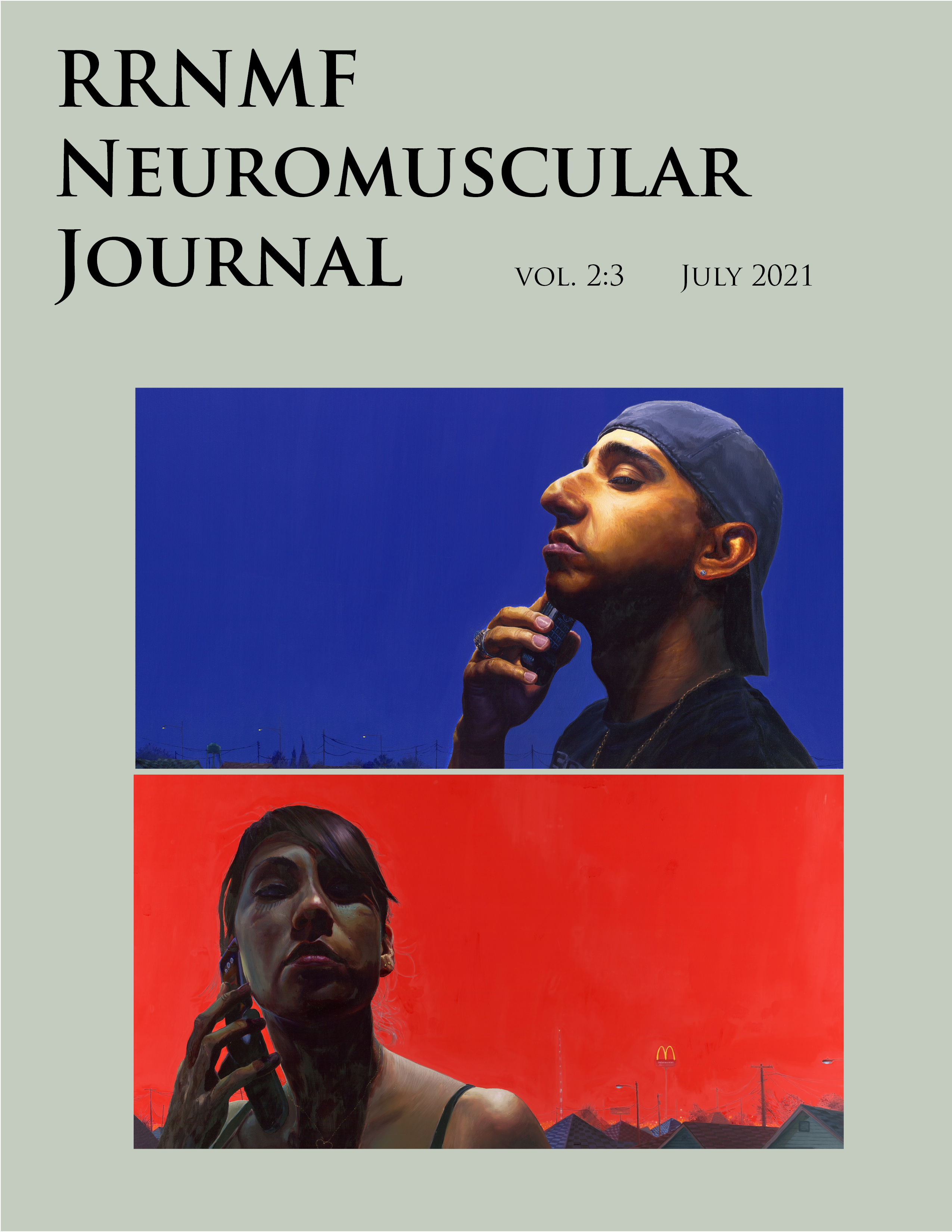Duration and temporal dispersion measurements in CIDP subjects from the Polyneuropathy And Treatment with Hizentra (PATH) study
DOI:
https://doi.org/10.17161/rrnmf.v2i3.15250Keywords:
cmap duration, temporal dispersion, chronic inflammatory demyelinating polyneuropathyAbstract
Abstract:
Introduction: Distal compound muscle action potential (dCMAP) duration and temporal dispersion (TD) are electrophysiological hallmarks of demyelination and important for the diagnosis of CIDP. While the impact of CIDP treatment on other nerve conduction parameters has been examined, the effects on dCMAP and TD remain unexplored. The aim of the study was to examine the impact of withdrawal of immunoglobulin treatment on dCMAP duration and TD, and also the influence of the measurement technique on dCMAP duration and TD.
Methods: Nerve conduction studies were analyzed from the PATH (Polyneuropathy And Treatment with Hizentra) study which randomized patients with CIDP to two doses of IgPro 20 and placebo. Distal CMAP duration and TD were obtained by two methods of measurements (D1 and D2, TD1 and TD2) from the median and peroneal nerves.
Results: The dCMAP and TD were obtained from 389 tracings. While the two methods of measurement showed differences in D1 and D2 with D2 longer than D1 in all the three groups, there was no difference between the TD1 and TD2. There was no difference at baseline in dCMAP duration or TD among the three groups. At the end of treatment, patients in the placebo arm had no worsening of dCMAP and TD compared to baseline or the treated groups.
Conclusion: dCMAP duration and TD did not show a difference between treated and placebo groups, and may be less sensitive measures than other nerve conduction parameters when evaluating changes in treatment. The method of dCMAP duration measurement does not affect TD as long as a consistent method is followed.
Downloads
References
References:
Joint Task Force of the EFNS and the PNS. European Federation of Neurological Societies/Peripheral Nerve Society Guideline on management of chronic inflammatory demyelinating polyradiculoneuropathy: Report of a joint task force of the European Federation of Neurological Societies and the Peripheral Nerve Society - First Revision. Journal of the Peripheral Nervous System 2010;15:1–9. https://doi.org/10.1111/j.1529-8027.2010.00245.x.
Bril V, Hartung H-P, Lawo J-P, Durn BL, Mielke O. Electrophysiological testing in chronic inflammatory demyelinating polyneuropathy patients treated with subcutaneous immunoglobulin: The Polyneuropathy And Treatment with Hizentra (PATH) study. Clinical Neurophysiology 2020. https://doi.org/10.1016/j.clinph.2020.09.001.
Bril V, Katzberg H, Donofrio P, Banach M, Dalakas MC, Deng C, et al. Electrophysiology in chronic inflammatory demyelinating polyneuropathy with IGIV. Muscle Nerve 2009;39:448–55. https://doi.org/10.1002/mus.21236.
Chin RL, Deng C, Bril V, Hartung H-P, Merkies ISJ, Donofrio PD, et al. Follow-up nerve conduction studies in CIDP after treatment with IGIV-C: Comparison of patients with and without subsequent relapse. Muscle Nerve 2015;52:498–502. https://doi.org/10.1002/mus.24624.
Ellrichmann G, Gold R, Ayzenberg I, Yoon M-S, Schneider-Gold C. Two years’ long-term follow up in chronic inflammatory demyelinating polyradiculoneuropathy: efficacy of intravenous immunoglobulin treatment. Ther Adv Neurol Disord 2017;10:91–101. https://doi.org/10.1177/1756285616679369.
Bril V, Banach M, Dalakas MC, Deng C, Donofrio P, Hanna K, et al. Electrophysiologic correlations with clinical outcomes in CIDP. Muscle & Nerve 2010;42:492–7. https://doi.org/10.1002/mus.21733.
van Schaik IN, Bril V, van Geloven N, Hartung H-P, Lewis RA, Sobue G, et al. Subcutaneous immunoglobulin for maintenance treatment in chronic inflammatory demyelinating polyneuropathy (PATH): a randomised, double-blind, placebo-controlled, phase 3 trial. The Lancet Neurology 2018;17:35–46. https://doi.org/10.1016/S1474-4422(17)30378-2.
guidelineConsensusCriteria.pdf n.d.
Preston DC, Shapiro BE. 3 - Basic Nerve Conduction Studies. In: Preston DC, Shapiro BE, editors. Electromyography and Neuromuscular Disorders (Third Edition), London: W.B. Saunders; 2013, p. 19–35. https://doi.org/10.1016/B978-1-4557-2672-1.00003-9.
Thaisetthawatkul P, Logigian EL, Herrmann DN. Dispersion of the distal compound muscle action potential as a diagnostic criterion for chronic inflammatory demyelinating polyneuropathy. Neurology 2002;59:1526–32. https://doi.org/10.1212/01.WNL.0000034172.47882.20.
guidelineConsensusCriteria.pdf n.d.
Ferrante MA, Bs TS, Tsao BE. Principles of Nerve Conduction Studies and Needle EMG n.d.:35.
Oh SJ, Kim DE, Kuruoglu HR. What is the best diagnostic index of conduction block and temporal dispersion? Muscle & Nerve 1994;17:489–93. https://doi.org/10.1002/mus.880170504.
Lagarde J, Viala K, Fournier E. Is total duration of distal compound muscle action potential better than negative peak duration in the diagnosis of chronic inflammatory demyelinating polyneuropathy? Muscle Nerve 2014;49:895–9. https://doi.org/10.1002/mus.24080.
Sander HW, Oh SJ. Temporal Dispersion Terminology: Multiphasic and Multiturn CMAPs. Journal of Clinical Neuromuscular Disease 2006;7:173–4. https://doi.org/10.1097/01.cnd.0000203642.77005.27.
Boërio D, Créange A, Hogrel J-Y, Guéguen A, Bertrand D, Lefaucheur J-P. Nerve excitability changes after intravenous immunoglobulin infusions in multifocal motor neuropathy and chronic inflammatory demyelinating neuropathy. J Neurol Sci 2010;292:63–71. https://doi.org/10.1016/j.jns.2010.02.002.
Lin CS-Y, Krishnan AV, Park SB, Kiernan MC. Modulatory effects on axonal function after intravenous immunoglobulin therapy in chronic inflammatory demyelinating polyneuropathy. Arch Neurol 2011;68:862–9. https://doi.org/10.1001/archneurol.2011.137.
Berger M, McCallus DE, Lin CS-Y. Rapid and reversible responses to IVIG in autoimmune neuromuscular diseases suggest mechanisms of action involving competition with functionally important autoantibodies. Journal of the Peripheral Nervous System 2013;18:275–96. https://doi.org/10.1111/jns5.12048.
Iijima M, Yamamoto M, Hirayama M, Tanaka F, Katsuno M, Mori K, et al. Clinical and electrophysiologic correlates of IVIg responsiveness in CIDP. Neurology 2005;64:1471–5. https://doi.org/10.1212/01.WNL.0000158680.89323.F8.
Khoo A, Frasca J, Schultz D. Measuring disease activity and predicting response to intravenous immunoglobulin in chronic inflammatory demyelinating polyneuropathy. Biomark Res 2019;7. https://doi.org/10.1186/s40364-019-0154-2.
Harbo T, Andersen H, Jakobsen J. Acute motor response following a single IVIG treatment course in chronic inflammatory demyelinating polyneuropathy. Muscle Nerve 2009;39:439–47. https://doi.org/10.1002/mus.21305.
Khomand P, Katzberg H, Ngo M, Bril V. Electrophysiological Responsiveness to Long-Term Therapy in Chronic Inflammatory Demyelinating Polyneuropathy: Case Report. CRN 2020;12:40–4. https://doi.org/10.1159/000505234.
Ghosh A, Virgincar A, Kennett R, Busby M, Donaghy M. The effect of treatment upon temporal dispersion in IvIg responsive multifocal motor neuropathy. J Neurol Neurosurg Psychiatry 2005;76:1269–72. https://doi.org/10.1136/jnnp.2004.050252.
Lafontaine S, Rasminsky M, Saida T, Sumner AJ. Conduction block in rat myelinated fibres following acute exposure to antigalactocerebroside serum. J Physiol 1982;323:287–306.
Downloads
Published
Issue
Section
License
Copyright (c) 2021 Deepak Menon, Joy Vijayan, John-Philip Lawo, Orell Mielke, Mylan Ngo, James Dela Cruz, Vera Bril

This work is licensed under a Creative Commons Attribution-NonCommercial-NoDerivatives 4.0 International License.

